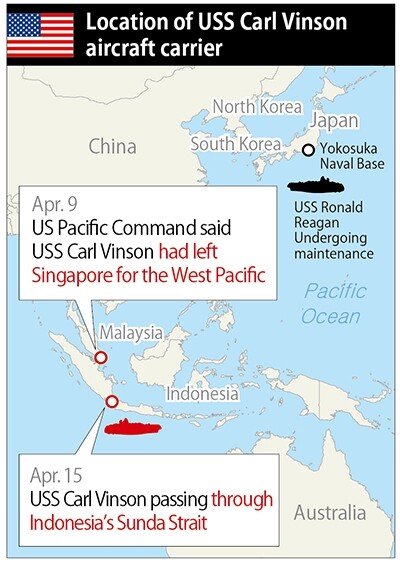hankyoreh
Links to other country sites 다른 나라 사이트 링크
[Correspondent’s column] Who played the starring and supporting roles in recent Korean peninsula crisis?

Rumors about a crisis on the Korean Peninsula have reappeared whenever there have been reasons for anxiety. Our constant exposure to these rumors is too distressing for us to accept them as the inescapable destiny of those who live on this divided peninsula. The rumors of crisis on the peninsula this April demand our reflection in particular since they plainly show how our neighbors act when South Korea has been weakened politically and economically.
To begin with, rumors of crisis typically used to be provoked by speculation about the North Korean regime collapsing when negotiations about the North Korean nuclear program reached an impasse or following incidents in the North such as the death of former leader Kim Jong-il in 2011. But the main actor and the epicenter of these rumors was the US government under President Donald Trump. The rumors were triggered by the “fake announcement” that the USS Carl Vinson, an American aircraft carrier, had abruptly changed course for the Korean Peninsula when it departed Singapore on Apr. 8. To be sure, there were many predictions that the North would carry out a nuclear test on Apr. 15, the Day of the Sun (which celebrates the birthday of North Korean founding leader Kim Il-sung). But since such predictions routinely accompany major events inside North Korea, there was nothing special about this year.

The Trump administration had to have known about the rapidly spreading rumors of a crisis on the Korean Peninsula, but it did nothing to stop them. If anything, Trump appeared to be actively trying to exploit these rumors for his domestic political ends. It appeared that the security and the anxiety of an ally’s citizenry had no place in their calculations. If the Trump administration’s objective was to use unpredictability to maximize its opponents’ fears, in keeping with Trump’s approach to bargaining, you could say that they succeeded – at least considering the vehement reactions from North Korea and China.
But the Trump administration needs to realize that its allies are also watching it with concern, lest the blade of this strategic ambiguity be turned against themselves. The strategy of crying wolf cannot remain effective for long. Furthermore, the Trump administration has a tendency to easily reverse itself, on both domestic and foreign policy, and it doesn’t appear to feel much responsibility for doing so. Once a country loses its most precious diplomatic asset of trust, it cannot help becoming a paper tiger, no matter how it may flex its muscles.
Without a doubt, Japan played a supporting role in the rumors of crisis on the Korean Peninsula. Japan resembled a hyena in its apparent attempts to fully exploit the government vacuum in South Korea. Japan’s Foreign Ministry posted a warning message on its website urging Japanese in South Korea to closely follow developments on the Korean Peninsula, while Japanese Prime Minister Shinzo Abe personally stoked the rumors about a crisis. It was the Japanese media that ran the false report that the US government was deploying not only the USS Carl Vinson but also the USS Nimitz, another supercarrier, to the waters of the Western Pacific Ocean. It was shocking to see the Japanese government and media apparently colluding to leak fake news and to heighten the crisis in South Korea.

Other supporting actors in the rumors of a crisis on the Korean Peninsula were the US media and the South Korean media. A false report by NBC on Apr. 13 stating that the US had deployed two destroyers carrying Tomahawk cruise missiles to waters near the Korean Peninsula brought the rumors of a crisis to their peak. While it’s likely that the US government deliberately provided reporters with false information, I wonder if those reporters bothered to consider what the consequences of their reporting might be.
In fact, it’s not just the US media that deserves to be reprimanded. Readers are recommended to glance through the front-page headlines for each newspaper and the titles for each news program in South Korea over the past ten days. An analyst at a think tank in Washington sarcastically concluded that the rumors of a crisis on the Korean Peninsula ultimately amounted to “synergy between the hastiness of the US and South Korean media.” Over the past 10 days, we were confronted with the all-too-grave fact that an accidental clash could have occurred on the Korean Peninsula. Let’s not forget who played the leading and supporting roles in the rumors of a crisis in Apr. 2017.
By Yi Yong-in, Washington correspondent
Please direct questions or comments to [english@hani.co.kr]

Editorial・opinion
![[Column] Season 2 of special prosecutor probe may be coming to Korea soon [Column] Season 2 of special prosecutor probe may be coming to Korea soon](https://flexible.img.hani.co.kr/flexible/normal/500/300/imgdb/original/2024/0426/3317141030699447.jpg) [Column] Season 2 of special prosecutor probe may be coming to Korea soon
[Column] Season 2 of special prosecutor probe may be coming to Korea soon![[Column] Park Geun-hye déjà vu in Yoon Suk-yeol [Column] Park Geun-hye déjà vu in Yoon Suk-yeol](https://flexible.img.hani.co.kr/flexible/normal/500/300/imgdb/original/2024/0424/651713945113788.jpg) [Column] Park Geun-hye déjà vu in Yoon Suk-yeol
[Column] Park Geun-hye déjà vu in Yoon Suk-yeol- [Editorial] New weight of N. Korea’s nuclear threats makes dialogue all the more urgent
- [Guest essay] The real reason Korea’s new right wants to dub Rhee a founding father
- [Column] ‘Choson’: Is it time we start referring to N. Korea in its own terms?
- [Editorial] Japan’s rewriting of history with Korea has gone too far
- [Column] The president’s questionable capacity for dialogue
- [Column] Are chaebol firms just pizza pies for families to divvy up as they please?
- [Column] Has Korea, too, crossed the Rubicon on China?
- [Correspondent’s column] In Japan’s alliance with US, echoes of its past alliances with UK
Most viewed articles
- 1‘We must say no’: Seoul defense chief on Korean, USFK involvement in hypothetical Taiwan crisis
- 2After election rout, Yoon’s left with 3 choices for dealing with the opposition
- 3Why Kim Jong-un is scrapping the term ‘Day of the Sun’ and toning down fanfare for predecessors
- 4AI is catching up with humans at a ‘shocking’ rate
- 5Two factors that’ll decide if Korea’s economy keeps on its upward trend
- 6Division commander ordered troops to enter raging flood waters before Marine died, survivor says
- 7[Column] Park Geun-hye déjà vu in Yoon Suk-yeol
- 8[Editorial] Korea’s surprise Q1 growth requires objective assessment, not blind fanfare
- 9No good, very bad game for Korea puts it out of Olympics for first time since 1988
- 10Noting shared ‘values,’ Korea hints at passport-free travel with Japan